live paintings: two streams
I’ll be doing this on Friday at 7 PST this week again, feel free to join in! If you have questions or suggestions, comment here or there. See you Friday!
I’ll be doing this on Friday at 7 PST this week again, feel free to join in! If you have questions or suggestions, comment here or there. See you Friday!
When you’ve lost someone close to you, tattooing is often a tool you can use in your grieving process. I do many memorial tattoos and I know from my own personal experience of getting them, that it can be really emotional.
The best thing to do, first of all, is to contact the artist and set up a consultation. Every artist is different, and what I do may not be what all artists do. So check in first, before assuming anything. That said, I deal with memorial tattoos by taking my cues from you. some people are light hearted, remembering good things. others are in mourning and need to cope with that. I’m not a therapist, just a person, so here is my take on memorials and how I set things up for you if you want one.
You might want your own soundtrack. This is fine- the shop doesn’t need to change their music for this to happen. The shop music is for the people working in the shop and we don’t change it- however I’m more than happy to work on you while you listen to your own calming music or meditation tracks on good headphones. If you don’t have good noise reduction headphones, let me know- I have over-the-ear ones that are amazing, and will keep out the hustle and bustle of the shop for you, so you feel safer. I’ll let you borrow them.
I’ll put up a screen if you’d like to have more privacy. Crying and feeling emotional are common things when we get memorial tattoos so please don’t feel worried if you need a moment to let it out, or if you get overwhelmed during the tattoo.
We can take breaks as needed. I usually charge for a break, if it’s one you need and not one I need- but in this case I stop the clock. i don’t charge for that time. It can take some minutes to calm down, to refocus. I respect that need and I want the tattoo to come out perfectly, so a little break for you to cry or breathe it out is OK. It’s not unusual and I’m not thinking poorly of you. There’s no need to get embarrassed about it. Everyone on earth loses things and people they love, and I have been through it too.
Bringing along comforting objects like books, photos or a pillow can help, especially if you have sensory issues. A familiar (clean) blanket and pillow are always ok. A photo for you to look at, a book, or videos through headphones. this can also help you remember the good times, and make your tattoo a celebration of the person’s life instead of just a sad moment thinking about the loss.
You’re welcome to bring a friend or loved one who is sharing in your grief, so that you can have someone to talk to, who really understands. I highly recommend this. Bringing someone along who also knew the person, or who is very supportive of you in your life, can really help. it’s difficult for me to both commiserate with you AND do the tattoo perfectly, so having that friend along to hold hands, tell stories, or just vent to, will help you get through things and still walk away with a good tattoo.
I do a lot of lettering, dates of birth and death, names, as memorials. This is very classic and totally ok. It’s just fine to do a memorial that’s simple and understated. I also do a lot of meaningful images related to the person who died. If there was an in joke between you, a pet name, or something you both loved, using an image of that as your memorial is a great idea and a really good way to remember the person going forward- as someone who had a positive impact on your life in an active way.
think of your loved one as a star. what were their greatest hits? what was their joy in life? did they create something wonderful, do something valuable? these are all good ways to think of images to memorialize them, rather than just letters.
I’ve also done tattoos that include cremains. This involves several steps- you’ll have to sift the ashes to get the lightest, finest ash. I’ll only need a tiny bit (the ink cup I use to pour out your ink into is very tiny, think a few drops) so a little sprinkling on top of that tiny cup is what we will use. You’ll need to bring them in the day before your appointment, so I can sterilize them for use and let them dry out. Then we will dust a small bit of them on top of the black ink we will be using. Cremains in tattoos is a debatable issue and a lot of tattoo artists will refuse to do this, and the do have good reasons. you may lose spots of ink during healing, since the ash has larger particles than the ink. However by sterilizing them ahead of time, we avoid any possible bacterial contamination of them and any other risks.
If your tattoo is a memorial don’t be shy about telling me or asking about these things. I’ve got memorial tattoos. I cried during a few of them. I wore headphones, hugged someone’s t shirt that smelled like them, I took breaks and I felt miserable. The process itself, though, seemed to help me work through my more awful feelings- and having someone there to discuss the good times with, seemed to help me the most.
we all grieve differently. if you’re getting a memorial tattoo, we should have a consult before your appointment, just to be sure we get everything settled for you, so you can use the process instead of feeling worse. Again, my concern is to do a good tattoo on you, that will give you positive feelings as you wear it over the years.
I’m not a therapist and I can’t help with the grieving process on that level. all I can do is give you a hug, and schedule you at the end of my day so I’m not bringing the weight of that loss in to my next appointment.
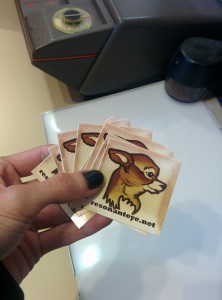 Seminar: Passive income and social media use for tattooers.
Seminar: Passive income and social media use for tattooers.
Even though we all make our daily bread tattooing, we all are also human beings, living inside bodies that can get broken or worn. When you’ve got slow times or an injury or illness, passive income is a good backup, and if done properly it will complement and improve your work on skin.
If you’re using social media at all- to share your tattoo work – or if you would like to start selling your other artwork online to reach a wider audience- this class is for you.
If you see the internet ad social media as a chore, hate pinterest, and fear theft- this class is for you.
Learn to use social media properly — without compromising your copyright.
This class relates to the sale of secondary mediums beyond tattooing, and will go over the relationship between your existing client base and the collectors who will buy your work on paper rather than skin.
We’ll cover print-on-demand services, pros and cons of social media use, networking as a strategy to find collectors, consolidating your media management, and getting more reach with your work online.
Seminar text and cheatsheet handout packet, aftercare instructions, and legal consent form templates included.
ONLINE AVAILABILITY OF WRITTEN MATERIALS HERE
On Sunday, September 11, I’ll be teaching my seminar on the use of social media and the internet for passive income, for tattooers. This seminar includes a huge packet of resources and information as well as access to a private group on which you can ask follow up questions, get recent information on changes, and talk and network with anyone else who’s taken the course. Location: Electric Eye Candy Tattoo Extravaganza
you do not have to be working at the convention to come to this seminar.
It’s a two-hour seminar- usually runs a bit longer for questions. I cover “branding”, username and site selection, basics of building a site, consolidating media, passive income streams, how to leverage your client base and word-of-mouth to reach further online, how to protect your copyright, and go over free or cheap tools you can use to share your work.
Even though we all make our daily bread tattooing, we all are also human beings, living inside bodies that can get broken or worn. When you’ve got slow times or an injury or illness, passive income is a good backup, and if done properly it will complement and improve your work on skin.
If you’re using social media at all- to share your tattoo work – or if you would like to start selling your other artwork online to reach a wider audience- this class is for you.
the course does count as continuing education credit for two hours. (I know a lot of you may not need that accreditation, but in some states your license requires this and yes, this seminar counts)
at this convention the seminar will cost $100 per person. tattoo artists at any level AND apprentices, are welcome. if you are an artist in another medium you may attend as well, although a lot of the information may be things you cannot utilize the same way.
to pre-register, email me at re*********@gm***.com. I accept paypal and Square. you can also show up on Sunday and pay at the door with cash or credit.
Bring pen or pencil, a piece of art you’ve made (or an image of one) and your smartphone, tablet, or laptop. there will be a wifi hotspot in the room for everyone to use as you follow along with the class.
If you’d like to speak to people who have taken this seminar to find out more, you can ask Curby Dickens, Bonnie Gillson, or Joanne Martian. All three have put a lot of the information to good use.
I can’t wait to meet you guys, I hope we have a good turnout, and good questions asked at the end! xox
if I’m working every day, all I do is wipe down my brushes with regular turpentine and maybe plain veg oil at the end of the night and forget about it. If you’re using oil brushes every day, they don’t have a chance to dry out.
Since I’m taking a few days off for Solstice, I need to actually clean my brushes!
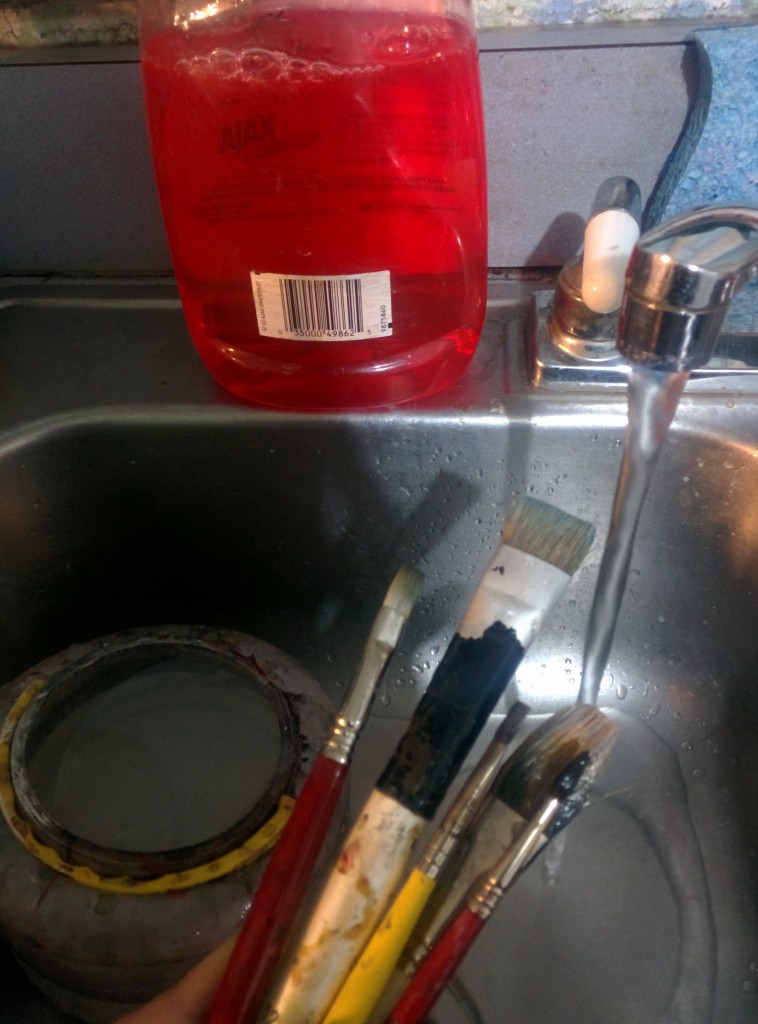
there are good and fancy soaps for this. I just use oil-breaker dish detergent. this is a generic brand, but blue dawn works pretty well.
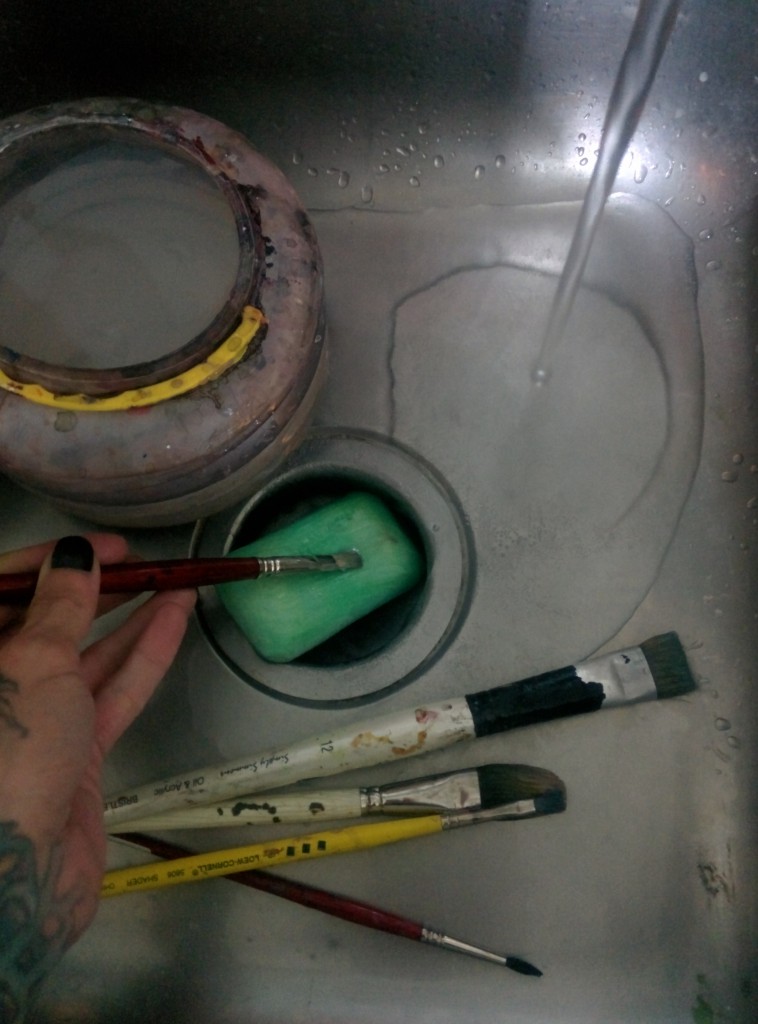
again, there’s fancy and better suited soaps for this, but I use the cheapest bar soap for ‘oily skin’. I use the dish soap to get most paint and solvent off, then use this to really scrub all the way up to the base where the bristles attach. then I rinse it all out.
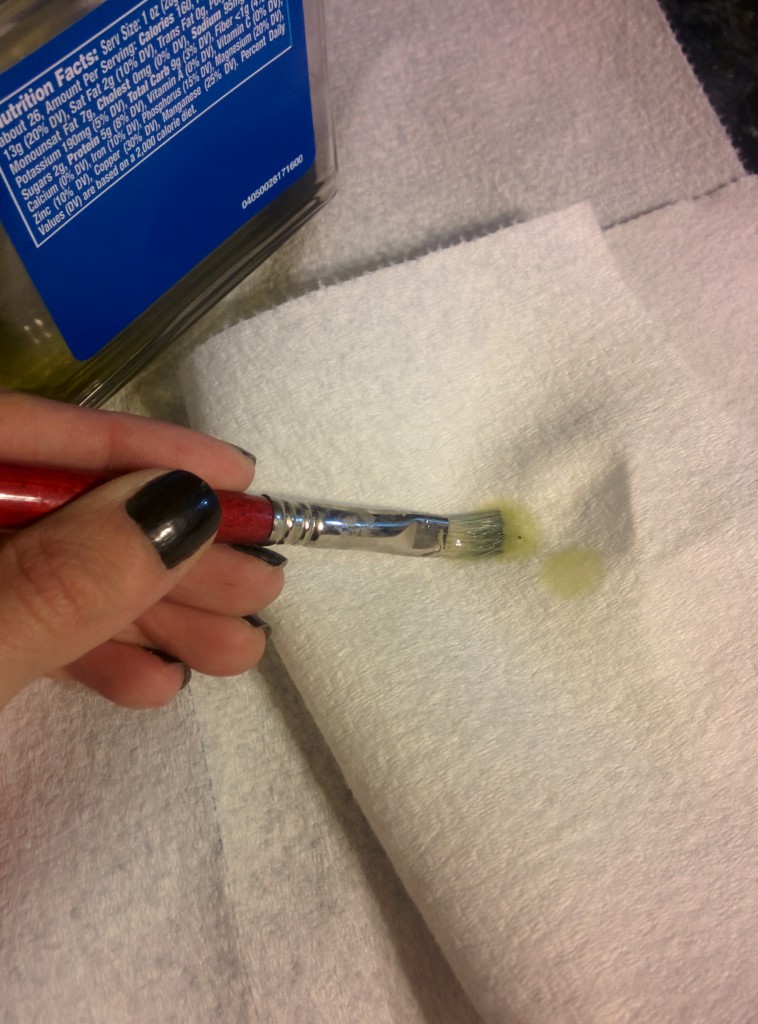
Then I wipe almost all of it off the brush. I leave them just greasy enough to hold their shape. If you use natural bristles you can use conditioner for this (like you’d use on your hair) but if you’re broke or cheap, this works fine.
Some of the materials I use are weird. Other are pretty common. I use odorless turpentine. The cheap stuff. I use old paints because I was given a huge box of many tubes of the basic colors in oil when a friend’s aunt died (she had been a painter of still lifes) so my paint choices are the odd thing.
I use a lot of yellow ochre, real madder. Payne’s grey, Naples yellow, prussian blue and lead white. I have some french ultramarine and viridian in there, but I use them less often. I have raw umber, burnt sienna, cad red, vermilion, and lamp and ivory black too.
I don’t have any burnt umber except for in miscible oils- I have a handful of those, burnt sienna, cadmium yellow, burnt umber, ultramarine, titanium white and lamp black. Not too many tubes of that stuff. I got those to do my giant animal painting project and I’m not sure what else I’ll use them for. I like the oily oils a little better, but these mix in just the same.
Water-miscible oils- I have there some brushes (oil brushes), a cup of water, some liquin, and the paints. I started out using water and paint for the underpainting, which dried pretty fast, overnight. Then started in with paint and liquin, then on to fat paint on its own.
Here’s another painting in the miscible oils. All I had out was the brushes, palette, liquin, and water cup. Almost as simple as working in watercolor.
I like really soft fat brushes. I only have maybe one or two hog bristle brushes even though I know most oil painters like them. I have one big one and one little one for oils. The rest of my brushes are synthetic, pretty much- mostly filberts and a few chisels. I have a big flat short-bristle brush I use to blend, it’s squirrel instead of sable but it’s soft enough to work well. I do have maybe two small sable brushes and a super silky rigger brush.
I’m sure if I was trained and taught by someone academic I’d know more about all this and make different choices.
I don’t have a lot of money for brushes so that’s about it for that. I try to take care of them but I am extremely bad at maintenance and remembering to clean them- I usually soak them up in turp and clean them every day when I’m done, and if I won’t paint for a day or more I wash them out as well as I can with detergent soap. Sometimes I forget and there’s a casualty. I get a new brush once or twice a year. I used to paint in oils almost only, but for a few years now I’ve worked in watercolor too so I switch back and forth every few months. (I rarely, if ever, use acrylics for anything)
Right now I have liquin and some old old copal as mediums. Liquin is good, it dries fast enough that I can work over an area within a few days, or the next day if I get aggressive with it (like in an underpainting) and the copal I think looks good as a top surface or glaze. I really wish I had more glazes and varnishes though, I’d love to try a few new things for that. I have had stand oil, and used it, I think I have a tiny bit left. It takes a while to dry out completely but it looks really cool and glossy if I’m doing a painting without much texture.
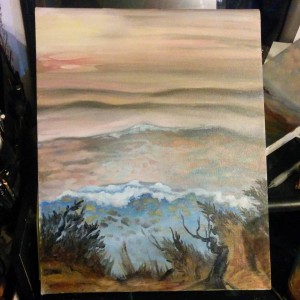 Once I have that first layer in I let things dry a little. Then I use more pigment, less media (turp or liquin) and lay in color. This bigger seascape, you’re seeing layer two. Basic color areas.
Once I have that first layer in I let things dry a little. Then I use more pigment, less media (turp or liquin) and lay in color. This bigger seascape, you’re seeing layer two. Basic color areas.
Here you can see the kinds of brushes I’m using on the bigger painting. One is a large, super super soft brush that I’m using to soften up all of the stuff I don’t want emphasized. I really only want the center area where the one wave breaks to be important, so I go through and soften the other areas once they are a little bit tacky. You can see I’ve added a lot of detail areas above that second wave there, little bits of grey and of the cad red that’s in the sky.
 Here is the little seascape that I made as a warmup, it’s done I think. I even signed it.
Here is the little seascape that I made as a warmup, it’s done I think. I even signed it.
I have had insomnia for about a week so most of my work has been happening at night. After a while my sleep schedule will head back on around the clock though, I’m sure.
I will probably do a materials list for watercolor or pen and ink wash stuff next monday. xox
Here is the finished foggy dawn Lincoln City landscape (click image for bigger image and prints)
I’m putting this one in a silvered wooden frame.
And here is the finished larger painting of the cliff south of yachats, in a nice antique oiled wood frame. I’ll scan it for prints when it is completely dry and right before I varnish it. I don’t know when the originals will be for sale, as I need to amass a handful for a gallery show this year.
I wanted to show you what I use with my oils. in this photo you can see at the top left an expandable wash bucket. I use detergent in the water, this is for any washing I have to do with my brushes, but I usually don’t. if you paint every day and rinse the brushes with turp when you’re done they stay soft.
in front of that you can see a good example of modernization. in the left is a bottle of “copal”. this new product is not copal, which is made from amber/pine resin, instead it’s some citric junk. next to itf you can see a corked bottle of real copal, which I’ve got a jug of hidden away from many years ago and dole out to myself in small quantities. I’ve been using this small jar for about a year.
in front of that is a sealable jar I use for turp. I get the odorless but it still stinks. I use this while I’m working to wipe paint off the brushes. nothing else.
on the right
you can see my paints. they’re antique, I inherited them. the cadmium paints I use aren’t hues (substitution colors) but real cad reds and yellows. it’s poisonous so I can’t eat a sandwich while I work. I’ve got a smallish tube of real rose madder which I hoard. this and the ultramarine are also very old. I think maybe 40s-60s era based on what I was told. they’re heavy pigments, really rich compared to the newer brands I tried. I use lead white from the same batch as well, I’ve got a lot of that. more poison!
the brushes- that big one is hog bristle. the next biggest is synthetic sable and very soft, I use it to blend. there’s a stippler there I use for scrubbing color into or off of the canvas. a few filbert and bright firm synthetics, small chisels, and then a really nice long real sable rigger.
I use a mayo tray as a palette, I’ve bought a few over the years for tattooing but this one got dented while I was traveling so it’s a palette now. I cover it with clingwrap at the end of the day so my paint stays soft.
Here you can see everything set up for working. I use a mayo tray that unfortunately got dented as a palette. I’m working on two paintings, more about those in a minute. you can see I use a lot of paper towels too as well as a rough old rag. The not-paint-water mug makes its usual appearance, though when I work in oil it just holds the brushes. I don’t trust my brain. There is a bottle of Bob Ross gesso in this photograph. It is empty, I like having it there though. It reminds me not to eat paint.
This is an underpainting, I don’t do them every time but this time I did. I then screwed up the painting beyond repair with some bad composition choices so it’s going to get scrubbed and I’ll reuse the canvas for another thing.
Here is a terrible blurry photo of the little seascape, which I think will turn out just fine.
This is a thin first layer just to lay in shape and tone. It’ll get a second layer, some detail and smoothing, and a glaze.
I don’t use a lot of medium, I have liquin if I’m impatient and a stand oil too just in case but mostly I work fat, just paint, and heavy and thick. it takes a long time to dry but I like the look. the copal is my glaze at the end.
I use liquin early on, I like the early layers to dry fast. I keep two or three pieces going at once in oil, so something is always ready to be worked on. Going back and forth from watercolor is like stepping onto the ground from a carousel, though. Takes me a minute to get my sea legs back.
You have seen my watercolor setup, which is a lot simpler.
I trust myself more when it’s water and not turp in the mug. All these things have been put away for a few weeks so I can work with oil for a bit. Then the oils will get packed into the box and these things will come back out. I used to have a few dining room tables, each with a different medium set up on it, so I didn’t have to pack things away like this. Right now my space is very limited so it’s one thing at a time. We are supposed to be putting in a shed studio though, so maybe that will change.
I also want to mention the fantastic magazine Brut Force, which recently interviewed me. The whole magazine is great and I feel a little out of my depth being in there among so many beautiful creative artists and their work. You can read about that here. I usually do not use the telephone but the interviewer had a good bedside manner and he got me through it with aplomb.
As a last thought, I’m planning to start scheduling posts by topic; I think mondays will be tech/materials day, tues will be tattoo advice or informaion, weds will be process shots, thrs or fri will be tattoo or other photos.
This streaming video contains about 2/3 of the information I present in my seminar. You can stream it as much as you like, pause and play, rewind, and take notes all you want.
If you’ve taken my seminar in person, email me to get the free version of this. If you stream this and wish to take my seminar in person, email me and you will get a discount when you attend!
All feedback is welcome. I hope this information helps you- it’s hard-won.
 I’ll be teaching a seminar at the PDX expo in October!
I’ll be teaching a seminar at the PDX expo in October!
Click through here for more info and to sign up. Bring notepad, pen/pencil, phone or tablet, and questions when you show up for the class. Counts for two hours of continuing education!
Leveraging Social Media to Sell Art Online, for Tattooers
Learn to use social media properly — without compromising your copyright. We’ll cover print-on-demand services, pros and cons of social media use, networking as a strategy to find collectors, consolidating your media management, and getting more reach with your work online.
This class relates to the sale of secondary mediums beyond tattooing, and will go over the relationship between your existing client base and the collectors who will buy your work on paper rather than skin.
This is a unique website which will require a more modern browser to work!
Please upgrade today!